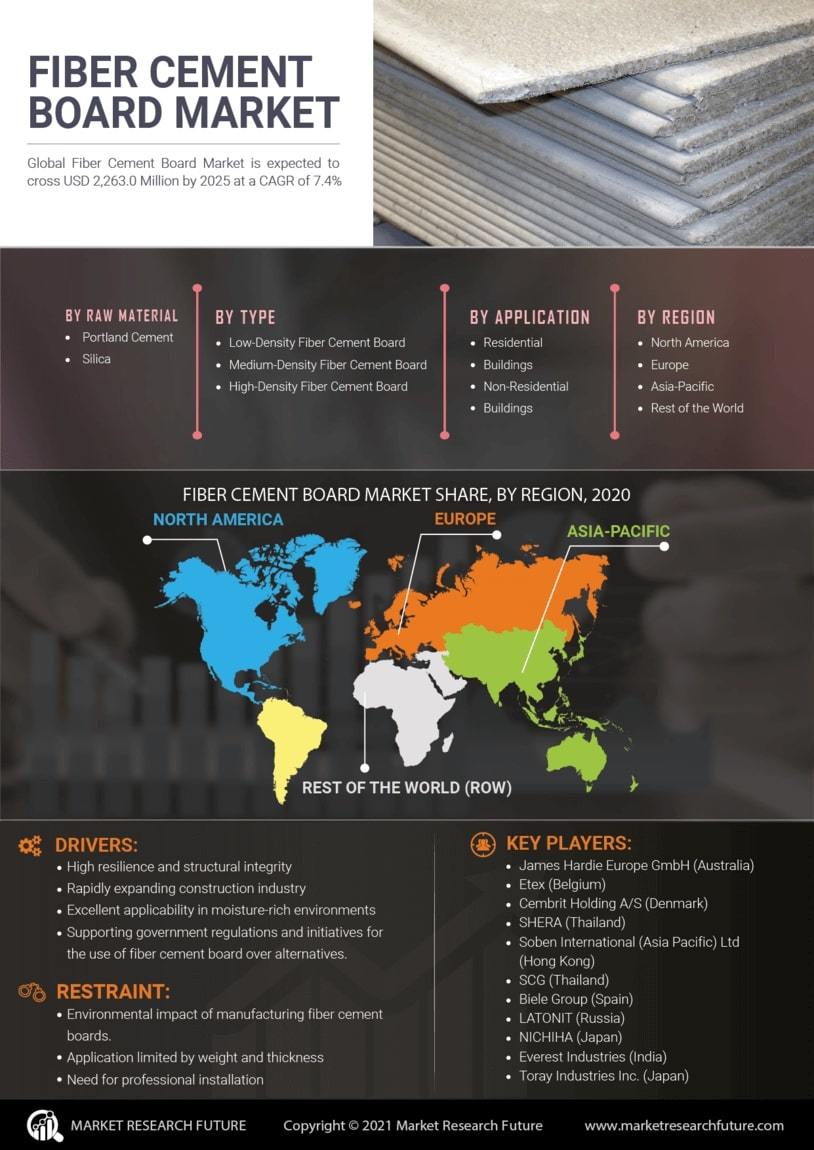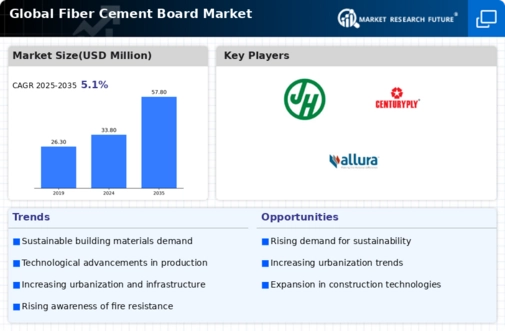Market Growth Projections
The Global Fiber Cement Board Market Industry is projected to witness substantial growth in the coming years. With an estimated market value of 33.8 USD Billion in 2024, the industry is on a trajectory to reach 57.8 USD Billion by 2035. This growth is indicative of the increasing adoption of fiber cement boards in construction projects worldwide. The anticipated compound annual growth rate (CAGR) of 5.02% from 2025 to 2035 further underscores the market's potential. Such projections reflect the ongoing demand for durable, sustainable building materials that meet modern construction standards, positioning fiber cement boards as a vital component of the future construction landscape.
Increasing Construction Activities
The Global Fiber Cement Board Market Industry is experiencing a surge due to escalating construction activities worldwide. As urbanization continues to rise, particularly in developing nations, the demand for durable and sustainable building materials is increasing. Fiber cement boards, known for their strength and resistance to weather conditions, are becoming a preferred choice among builders and architects. In 2024, the market is projected to reach 33.8 USD Billion, reflecting the growing inclination towards modern construction techniques that prioritize longevity and environmental sustainability. This trend is likely to bolster the market further as infrastructure projects expand globally.
Diverse Applications Across Industries
The versatility of fiber cement boards is a key driver for the Global Fiber Cement Board Market Industry. These boards are utilized in various applications, including residential, commercial, and industrial sectors. Their resistance to moisture, fire, and pests makes them suitable for a wide range of environments. As industries seek durable and low-maintenance materials, the demand for fiber cement boards is expected to rise. This broad applicability is anticipated to support the market's expansion, particularly as construction practices evolve to incorporate more innovative materials. The ongoing diversification of applications is likely to sustain interest in fiber cement boards across multiple sectors.
Growing Awareness of Sustainable Materials
There is a notable shift towards sustainability in the construction sector, significantly impacting the Global Fiber Cement Board Market Industry. As environmental concerns gain traction, builders and consumers are increasingly opting for eco-friendly materials. Fiber cement boards, made from natural raw materials, offer an alternative to traditional wood and plastic products, which often contribute to deforestation and pollution. This growing awareness is expected to drive market growth, with projections indicating a rise to 57.8 USD Billion by 2035. The emphasis on sustainable construction practices aligns with global initiatives aimed at reducing carbon footprints, thereby enhancing the appeal of fiber cement boards.
Technological Advancements in Manufacturing
Technological innovations in the production of fiber cement boards are significantly influencing the Global Fiber Cement Board Market Industry. Enhanced manufacturing processes have led to improved product quality, durability, and performance. These advancements enable manufacturers to produce lighter, more versatile boards that cater to diverse applications, from residential to commercial projects. As a result, the market is poised for growth, with a projected compound annual growth rate (CAGR) of 5.02% from 2025 to 2035. The integration of advanced technologies not only boosts efficiency but also reduces waste, aligning with the industry's shift towards sustainability and resource optimization.
Regulatory Support for Green Building Initiatives
Government regulations promoting green building practices are playing a pivotal role in shaping the Global Fiber Cement Board Market Industry. Many countries are implementing stringent building codes that encourage the use of sustainable materials, including fiber cement boards. These regulations often provide incentives for builders who choose eco-friendly options, thereby increasing the market's attractiveness. As urban areas expand and the demand for sustainable construction rises, the fiber cement board market is likely to benefit from this regulatory support. This trend is expected to contribute to the market's growth trajectory, reinforcing the importance of compliance with environmental standards.














Leave a Comment